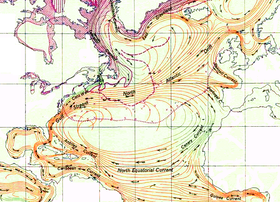
The North Atlantic Gyre of the Atlantic Ocean is one of five great oceanic gyres. It is a circular ocean current, with offshoot eddies and sub-gyres, across the North Atlantic from the Intertropical Convergence Zone (calms or doldrums) to the part south of Iceland, and from the east coasts of North America to the west coasts of Europe and Africa.
In turn it is chiefly subdivided into the Gulf Stream flowing northward along the west; its often conflated continuation, the North Atlantic Current across the north; the Canary Current flowing southward along the east; and the Atlantic's North Equatorial Current in the south. The gyre has a pronounced thermohaline circulation, bringing salty water west from the Mediterranean Sea and then north to form the North Atlantic Deep Water.
The gyre traps anthropogenic (human-made) marine debris in its natural garbage or flotsam patch, in the same way the North Pacific Gyre has the Great Pacific Garbage Patch.[1]
At the heart of the gyre is the Sargasso Sea, noted for its still waters and quite dense seaweed accumulations.
- ^ Lavender Law, Kara; S. Moret-Fergusen; N. Maximenko; et al. (2010). "Plastic accumulation in the north atlantic subtropical gyre". Science. 329 (5996): 1185–8. Bibcode:2010Sci...329.1185L. doi:10.1126/science.1192321. PMID 20724586. S2CID 13552090.